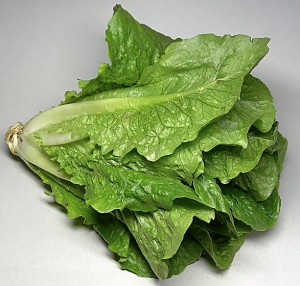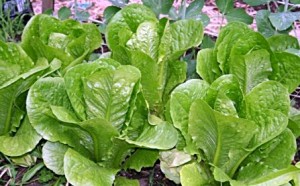 Romaine Lettuce, also known as cos lettuce (Lactuca sativa), is a type of lettuce that is characterized by dark green leaves that grow upright and curl inward from lighter colored stems. Unlike most lettuces, it is tolerant of heat. Romaine is the usual lettuce in Middle Eastern cuisine and used in Caesar salad. These leaves are particularly fragile compared to other types of lettuce and are often damaged in shipment, making it the least widely grown type of lettuce. Other similar varieties include a sweet romaine and a more mild variety that is characterized by red-tipped leaves.
Romaine Lettuce, also known as cos lettuce (Lactuca sativa), is a type of lettuce that is characterized by dark green leaves that grow upright and curl inward from lighter colored stems. Unlike most lettuces, it is tolerant of heat. Romaine is the usual lettuce in Middle Eastern cuisine and used in Caesar salad. These leaves are particularly fragile compared to other types of lettuce and are often damaged in shipment, making it the least widely grown type of lettuce. Other similar varieties include a sweet romaine and a more mild variety that is characterized by red-tipped leaves.
The deeper green colors of romaine lettuce give it a deeper and more flavorful taste than other types of lettuce such as butterhead and crisphead lettuce. The inner leaves of romaine lettuce have a lighter color than the outside leaves, resulting in a lighter flavor as well. Like some the others, Romaine lettuce is also a crunchy lettuce, but the darker green parts of the leaves happen to be softer than the light-colored stems.
The nutritional benefits of Romaine lettuce include an abundance of vitamin A, beta-carotene, vitamin K, folic acid and vitamin C to name a few. All of these nutrients are essential for a diet that is considered to be healthy for the heart, and can be an important part of any daily diet. Not only this, but romaine lettuce is also listed as a food that fights cancer by the American Institute for Cancer Research.
Romaine has been cultivated and eaten cooked or raw for almost 5,000 years and may very well be the oldest form of cultivated lettuce.

How to grow Romaine Lettuce
If you love to eat salad, specially salads where there are lots of lettuce, then I think you will be interested in planting and harvesting your own lettuce. Searching for a variety of lettuce to plant seems not very hard because there is one popular choice, and that is, the romaine lettuce. The obvious reasons are fast growing, easy to harvest and forms a loose head. It also don’t require a large space and your backyard can be suitable if you have one. I’m no expert gardener and not a gardener at all and I just got the information from the internet. The purpose of this post is just to give you an idea on what sideline or business you want to have specially this summer. Anyway, romaine lettuce loves cool weather and will thrive well on regions with a cool climate like in Baguio and Davao. But if we don’t live in a cooler regions of this country, then I think it is wise to choose cooler months like December to February and improvising a shade to protect the plants from the scorching heat of the sun.
- First buy a pack of Romaine lettuce seeds from the garden section of supermarkets. If you can’t find one you can contact Mr Seeds online. Next prepare the garden bed for planting the lettuce seeds. It is best to use compost or some organic materials for added nutrients for the plants.
- Before planting the seeds to the garden bed, put fertilizers. It should be done few weeks before planting. I think this step is optional because you already have organic materials on the soil. Just make sure the fertilizer you are going to use is appropriate for the romaine lettuce.
- Plant the lettuce seed directly on the soil. Since lettuce seeds are very fine, it’s hard to distribute them. The suggested spacing is 12 inches apart, in rows 18 inches apart. Planting the seeds directly on the garden bed will reduce the shock or worse the plant might die if not properly transplanted.
- Just in case you wanted to buy lettuce seedling or started planting the seeds indoor and later transplant it on the garden bed, make sure the weather is cool like a cloudy day or early evening or early morning to reduce the chances of killing the plant.
- Weed out the garden bed and make sure there are none left because lettuce roots are shallow.
- Approximately romaine lettuce will take about 60 to 70 days from planting to maturity. By then it is ready to harvest. If you want your lettuce to continue to grow for another harvest, just select the outermost leaves. But the quality will not be the same as the first harvest so it’s your choice if you want to start again from the seedling or leave the mature plant for another harvesting.
- After you gather the your harvest, wash it immediately and pat it dry. Place in plastic bags and store in your refrigerator for selling or just home use.
Source: eHow and gardenersnet.com; Photo: wikipedia